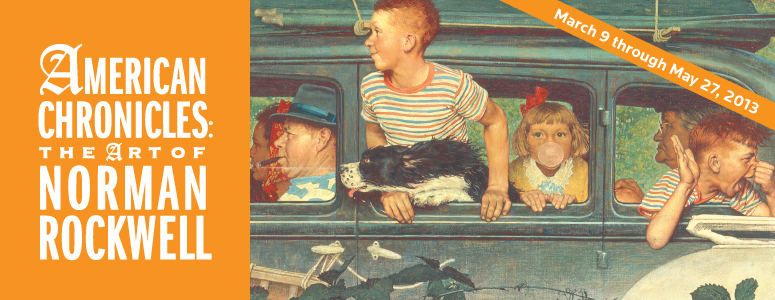Tulsa: March 2013 Archives
Time to tame the tabs. Here are a few articles worth your notice:
Natasha Ball has compiled This Land's list of 50 Best Spring Break Things to Do in Oklahoma. For all my years and all my travels, I see plenty of items that I have yet to accomplish and many more that I have yet to share with my kids.
 Something not on her list because it's not in Oklahoma, but worth a visit, and only about 2 hours east of Tulsa: Crystal Bridges Museum of American Art in Bentonville, Arkansas. Beautiful setting in a wooded ravine. Architecture that looks like the lair of a Bond villain. And for the next two months, through May 27, 2013, a wonderful exhibit of the art of Norman Rockwell -- full-sized paintings, many of them covers he did for the Saturday Evening Post.
Something not on her list because it's not in Oklahoma, but worth a visit, and only about 2 hours east of Tulsa: Crystal Bridges Museum of American Art in Bentonville, Arkansas. Beautiful setting in a wooded ravine. Architecture that looks like the lair of a Bond villain. And for the next two months, through May 27, 2013, a wonderful exhibit of the art of Norman Rockwell -- full-sized paintings, many of them covers he did for the Saturday Evening Post.
General admission to the museum is free, sponsored by Walmart. Admission to the Rockwell exhibit is $12 for adults; children 18 and under and museum members are admitted at no charge. There's an audio tour of the Rockwell exhibit at no extra charge -- well worth taking. It's an iPod Touch; you key in the number of the painting you're viewing for narration, sometimes including Norman Rockwell himself, a member of his family, or one of the models for the painting. We were there about a week ago and really enjoyed it. We needed two hours just to see the Rockwell exhibit.
Promoting your hometown for tourism is a tricky business. It may be a nice place to live, but why would anyone want to visit there? The Oklahoma-based blog Small Biz Survival has notes from a talk by Roger Brooks of Destination Development International on how to market a community, listing the common pitfalls of small-town marketing, most of which apply to places like Tulsa, too:
The first fact he mentioned is about how we search when we're looking for somewhere to go. We search on activity first, then location second. So we'll search "mountain biking western Oklahoma" or "sailing southern Ontario." Brooks' examples showed people searching on an activity and then a town name."Have you ever gone anywhere because they 'have something for everyone' or they are the 'gateway to' someplace else?" Brooks asked.
Brooks urged asking these questions:
- What do you have that the people you are hoping to attract can't get or do closer to home?
- What makes you worth a special trip?
- What sets you apart from everyone else?
It's long been a frustration to me that the tourist materials produced for Tulsa by a branch of the Tulsa Regional Chamber focus on Tulsa's sophistication and the kind of amenities you'd expect to find in any large American city. These brochures and booklets might reassure people who are thinking about relocating to Tulsa, but they won't attract visitors from around the country or around the world. On the other hand, Tulsa's truly unique features and history get downplayed. Brooks addresses the psychology that produces a generic and ineffective marketing message, and includes a list of phrases that should be banned from your tourism brochure, including so much to do, center of it all, best kept secret, outdoor recreation, and playground.
Streetsblog looks at why enclosed malls are dying even in small cities, like Effingham, Illinois.
Steve Lackmeyer at The Oklahoman covers what looks like defiance from Oklahoma City's public works department over the implementation of Project 180, the program to make downtown streets safer and easier to navigate for pedestrians, cyclists, and drivers alike.
At the Washington Free Beacon, there's a review of Detroit: An American Autopsy, a combination of investigative reporting and personal narrative on the decline and fall of a once-great metropolis. "An American Autopsy often reads like an old detective novel. There are mustachioed homicide detectives, hit men, con men, grifts and drugs, greed, and corruption."
Next American City reports on a Brookings Institution study of Amtrak ridership: Shorter trips (under 400 miles) have more riders and make more money than long-distance runs.